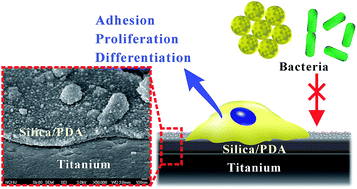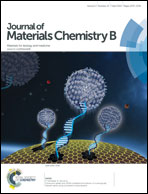Novel SiO2/PDA hybrid coatings to promote osteoblast-like cell expression on titanium implants
Abstract
Poor bonding between bone tissue and noble titanium (Ti) surfaces is one of the major problems that should be resolved. Given that SiO2 is a documented differentiation promoter and polydopamine (PDA) is an adhesive molecule, it is worthwhile to investigate the synergetic performance of novel silica/polydopamine (SiO2/PDA) hybrid coatings on Ti substrates. The physicochemical properties of PDA, 2SiPDA, 10SiPDA, and 20SiPDA coatings including the microstructure, bond strength and corrosion resistance, and in vitro antibacterial activity against P. aeruginosa and S. aureus were examined. In addition, the osteogenesis level of MG63 human osteoblast-like cells on the coatings was detected. The experimental results indicated that the precipitated SiO2 particles were within the PDA layer with sub-micro-scale thickness. The hybrid coating (20SiPDA) containing an appropriate amount of SiO2 did not adversely affect shear bond strength compared with the Ti control and pure PDA coating. The SiO2/PDA coatings could effectively enhance the corrosion resistant ability of Ti implants. The 20SiPDA coatings elicited higher mortality rates of bacterial strains compared with the Ti control and pure PDA coating. More importantly, the incorporation of SiO2 in the PDA coating layer could improve adhesion, proliferation, differentiation, and mineralization of MG63 osteoblasts. The new SiO2/PDA coating may be suitable for serving as a decorated layer to improve osteogenesis of Ti implants.


 Please wait while we load your content...
Please wait while we load your content...